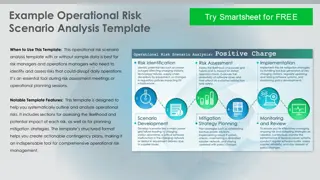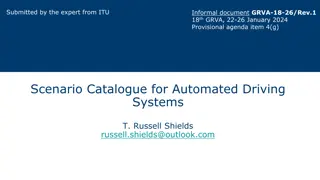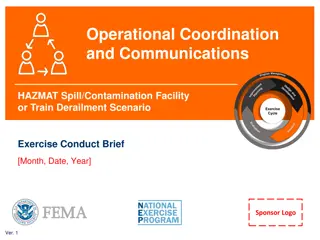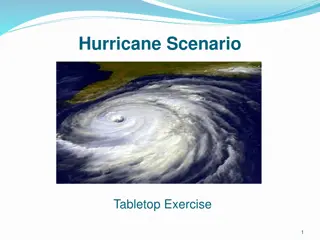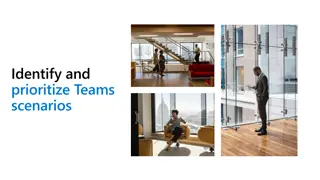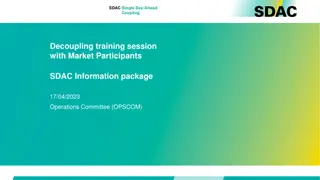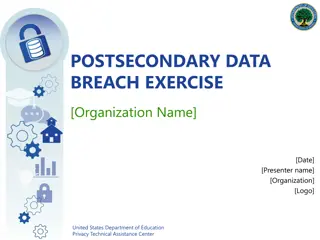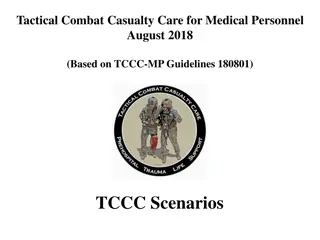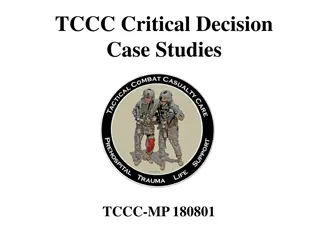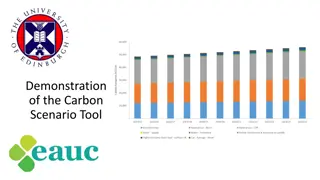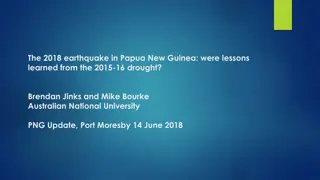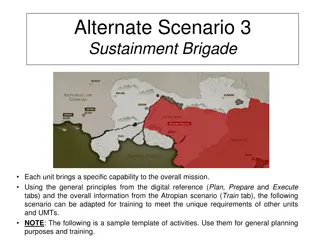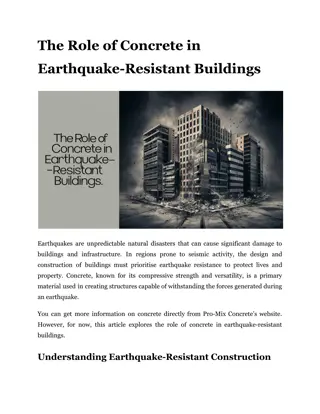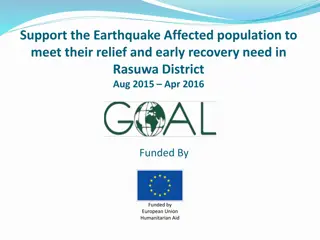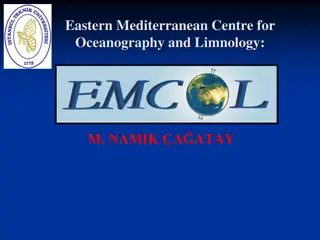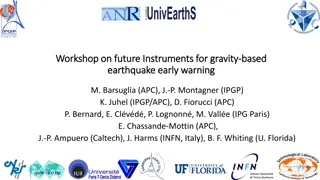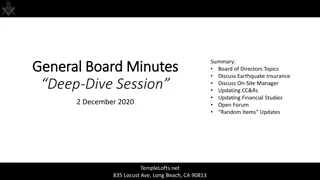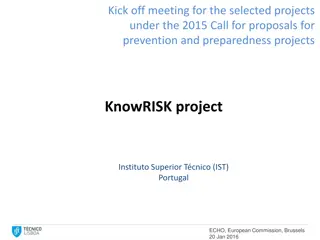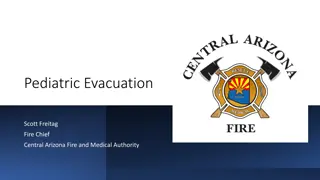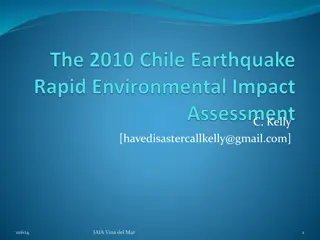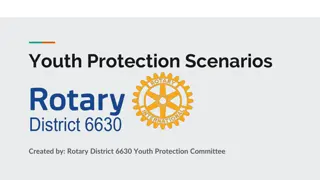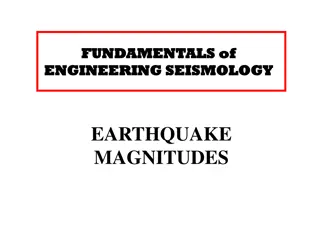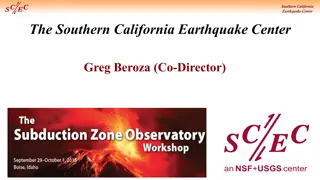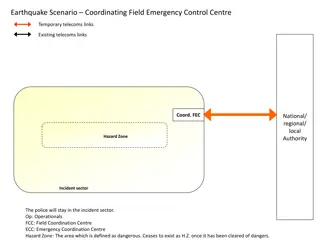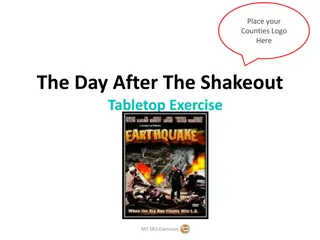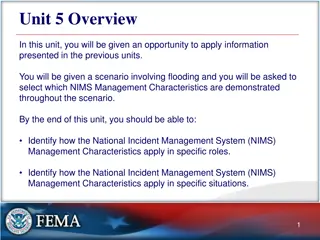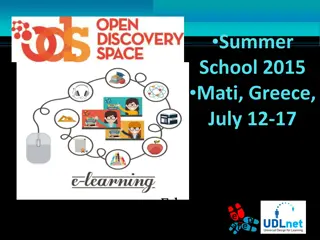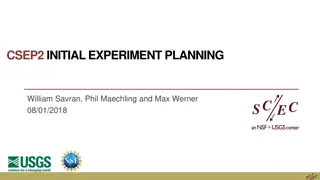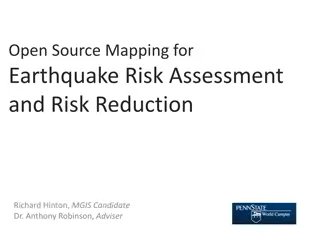Paladin Security Tabletop Exercise Template
In this tabletop exercise template by Paladin Security, participants have the opportunity to test the efficacy of emergency response plans in a safe environment that encourages active participation and respect for others. The exercise involves responding to a scenario and adapting strategies based o
3 views • 17 slides
Urgent Support Needed: Nepal Earthquake Relief Efforts
A devastating 7.8 magnitude earthquake hit Nepal, causing widespread damage and leaving 2.8 million people homeless. Families are desperate for shelter as monsoon rains approach. Habitat is mobilizing engineers to assess damage, provide emergency shelter kits, and support long-term rebuilding effort
2 views • 16 slides
Earthquake Safety and Design Considerations for Building Structures
Earthquake forces can lead to structural failure in buildings, posing a risk to lives and properties. Proper planning, reinforcement, and design elements such as bracing walls and tied members are essential for ensuring safety against earthquake forces. Additionally, consideration of soil type, qual
1 views • 22 slides
Comprehensive Operational Risk Scenario Analysis Template
This template aids risk and operations managers in systematically identifying, assessing, and mitigating operational risks that could disrupt daily business operations. It allows for detailed risk analysis, scenario development, and mitigation strategy planning to ensure effective risk management. C
0 views • 4 slides
Insights into Creating and Maintaining Catalogues for Automated Driving Systems
The document discusses the importance and challenges of developing scenario catalogues for Automated Driving Systems (ADS). It highlights the need for organized methods, user and IT expertise, common formats, and expert analysis in creating and maintaining such catalogues. The focus is on the scenar
0 views • 7 slides
Operational Coordination and Communications HAZMAT Scenario Exercise Conduct Brief
The document serves as the Hazardous Material Spill/Contamination Facility or Train Derailment Scenario Conduct Slide Deck for the Operational Coordination and Communications Principals Strategic Priority. It includes guidelines for tailoring the exercise to an organization's needs, conducting the s
0 views • 45 slides
Hurricane Scenario Tabletop Exercise: Enhancing Emergency Response Preparedness
Engage in a tabletop exercise focused on a hurricane scenario to enhance emergency response preparedness. The exercise includes introductions, agenda review, scenario discussions, action planning, and benefits such as improved readiness and skills practice in a safe environment. Objectives aim to re
0 views • 31 slides
Comprehensive Building Safety and Emergency Preparedness Training
Enhance your safety preparedness with Building Safety Coordinator Training, Emergency Preparedness resources, Communication Resources, Fire Safety procedures, and Earthquake Safety measures. Learn about fire extinguisher use, fire response procedures, earthquake safety considerations, and the seven
1 views • 30 slides
Effective Use Case Scenario Identification and Prioritization for Teams
Well-defined destination, business outcome focus, and scenario examples play crucial roles in identifying and prioritizing use case scenarios. Exercise tools guide teams in successful scenario identification while considering business impact, transformation, and quick wins. Sample scenarios and a st
0 views • 19 slides
Market Decoupling Training Session with SDAC Information Package
Decoupling training session organized for market participants to prepare for handling a full decoupling scenario in the SDAC market. The session includes background information, goals, scenario simulation, operational processes, coordination, evaluation, and fallback solutions. Date and timeslot set
2 views • 10 slides
Postsecondary Data Breach Exercise: Prepare for the Unexpected!
This tabletop exercise simulates a data breach scenario within a complex organization, engaging participants to make critical decisions and respond effectively. Teams will work together to uncover the extent of the breach and devise a response plan. Consider various roles needed in your organization
0 views • 31 slides
Understanding Progressive Hedging Algorithm in Operations Research Seminar
Explore the Progressive Hedging algorithm discussed in the Graduate Seminar on Operations Research. Topics include general framework, resource allocation examples, and handling non-convexity in decision-making. Dive into scenario decomposition and scenario-specific decision-making for well-hedged so
0 views • 28 slides
Tactical Combat Casualty Care in Action: SEAL Casualty Scenario in Afghanistan
Experience real-life combat trauma management in action through a SEAL casualty scenario in Afghanistan. Follow the first responder's account of assessing and treating a teammate with severe injuries, highlighting the challenges and critical decisions made in the field.
0 views • 109 slides
TCCC Critical Decision Case Studies: Bleeding Management Scenario
This presentation focuses on a critical decision case study in Tactical Combat Casualty Care (TCCC) involving a casualty with high amputations and ongoing massive hemorrhage. The scenario explores the challenges of managing uncontrolled bleeding in a combat situation and provides insights into the r
0 views • 139 slides
Maximizing Profits in Production Scenarios
Explore two production scenarios to maximize profits using optimization models. The first scenario involves a cookie store with constraints on cookie production and labor hours. The second scenario features a computer factory maximizing profit considering production line and labor constraints. Learn
0 views • 14 slides
Understanding the Carbon Scenario Tool for Climate Change Management
The Carbon Scenario Tool (CST) is a valuable resource developed by the University of Edinburgh and the Scottish Funding Council to manage, report, and forecast carbon emissions for university estates and operations. It enables the calculation of the impact of carbon reduction projects and the develo
2 views • 18 slides
Lessons Learned from Papua New Guinea's 2015-16 Drought in Dealing with the 2018 Earthquake
Exploring the correlation between the 2015-16 drought and the 2018 earthquake in Papua New Guinea offers valuable insights into disaster management strategies. Comparisons in impact, response, and long-term consequences highlight the importance of proactive measures and effective coordination in mit
0 views • 15 slides
Training Scenario for Sustainment Brigade Deployment Preparation
Adapted training scenario for deploying a sustainment brigade featuring specific unit capabilities and planning tasks for Phase 0 deployment at Fort Hood, TX. Includes analyzing mission specifics, integrating religious support, and executing deployment tasks. Detailed overview of the Atropian scenar
9 views • 7 slides
The Role of Concrete in Earthquake-Resistant Buildings
Discover how concrete enhances earthquake resilience in buildings. Learn key design features that make structures safer during seismic events.\n
6 views • 7 slides
Understanding Seismic Source Parameters in Earthquake Dynamics
The seismic source parameters in earthquake dynamics involve describing a fault as a discontinuity causing displacements, requiring a complex treatment of forces. The Earth's equilibrium necessitates a specific system of forces to explain displacements along faults. The seismic moment tensor, consis
4 views • 32 slides
Support for Earthquake-Affected Population in Rasuwa District, Aug 2015-Apr 2016
Support earthquake-affected population in Rasuwa District with shelter upgradation, material support, cash-for-work, livestock shed assistance, and earthquake-resistant techniques verification. Activities include distribution of shelter kits and tool kits, DRR training, mason training, construction
0 views • 13 slides
Eastern Mediterranean Centre for Oceanography and Limnology (EMCOL): Research Focus and Facilities
EMCOL, led by M. Namik A. Atay, focuses on natural hazards, environmental changes, and earthquake risk assessment. Their research fields include earthquakes, submarine landslides, tsunamis, sea-level changes, climate change, and paleoclimatology. The center conducts fieldwork using various equipment
0 views • 13 slides
Workshop on Future Instruments for Gravity Earthquake Early Warning
Explore the cutting-edge research and developments in instruments for gravity-based early warning systems for earthquakes. Experts like M. Barsuglia, J.-P. Montagner, and K. Juhel are leading the way in this crucial field. Discover the latest projects and collaborations shaping the future of earthqu
0 views • 8 slides
Prepare and Stay Safe: A Comprehensive Guide for Earthquake Preparedness
This comprehensive guide covers various aspects of earthquake preparedness, including potential risks, necessary precautions, and steps to take during and after an earthquake. It emphasizes the importance of personal, family, and community preparedness, along with valuable insights on how to reduce
0 views • 102 slides
Board of Directors Meeting Highlights - December 2, 2020
Discussions during the Board of Directors meeting revolved around crucial topics such as Earthquake Insurance, On-Site Manager updates, CC&Rs, Financial Studies, and General Board matters. Key decisions were made regarding appointments, resignations, and handling earthquake insurance issues. The mee
0 views • 9 slides
KnowRISK Project - Kick-Off Meeting and Objectives Overview
The KnowRISK project aims to reduce seismic risks through non-structural elements in buildings. The kick-off meeting highlighted the project framework, partners, objectives, and the importance of addressing non-structural elements for earthquake resilience. Objectives include bridging the gap betwee
0 views • 10 slides
Pediatric Evacuation in Response to 7.7 Magnitude Earthquake
Central Arizona Fire and Medical Authority Fire Chief, Scott Freitag, coordinates pediatric evacuation efforts following a 7.7 magnitude earthquake in Southern California. Numerous hospitals report structural damages necessitating the evacuation of pediatric patients who require specialized care and
0 views • 19 slides
Environmental Impact Assessment and Recovery Planning After the 2010 Chile Earthquake
The presentation discusses the Rapid Environmental Impact Assessment (REA) process conducted by a team of Chileans post the 2010 earthquake. It emphasizes the incorporation of assessment results into post-disaster recovery planning to address key issues such as disaster debris management, transition
0 views • 6 slides
Rotary District 6630 Youth Protection Scenarios
This content provides scenarios related to youth protection in a Rotary setting. Scenario #1 involves handling inappropriate behavior at a club meeting, while Scenario #2 addresses allegations of sexual harassment within an Interact club sponsored by Rotary. Key points for each scenario offer guidan
0 views • 15 slides
Understanding Earthquake Magnitudes and Seismic Measurements
Delve into the fundamentals of engineering seismology and earthquake magnitudes, exploring topics such as fault dimensions, slip distribution, spectral shapes, Richter's observations, and logarithmic scales. Gain insights into how seismic measurements are characterized and understand the significanc
0 views • 69 slides
Southern California Earthquake Center Overview
The Southern California Earthquake Center (SCEC) is a large consortium of institutions dedicated to coordinating earthquake research in Southern California. Their mission involves communicating earthquake understanding to reduce risk and improve community resilience, integrating information for a co
0 views • 22 slides
Seismic Site Characterization in Metropolitan Vancouver
The Greater Vancouver area faces high seismic risk due to its population density and critical infrastructure. Ground shaking during large earthquakes depends on various factors including the earthquake source, material properties, and site conditions. Efforts are being made to map seismic hazards, u
0 views • 13 slides
Comprehensive Earthquake Emergency Response Scenarios
This detailed content outlines various earthquake emergency response scenarios including coordinating field control centers, temporary and existing telecoms links, national/regional/local authorities' roles, hazard zones, incident sectors, and specific tasks for different emergency teams such as sea
0 views • 9 slides
Earthquake Response and Recovery Exercise Overview
This presentation outlines the objectives, goals, and purpose of a tabletop exercise focused on evaluating response and recovery efforts after an earthquake. It emphasizes educating decision-makers, defining roles, coordinating operations, sharing information, and enhancing community resilience to e
0 views • 15 slides
Innovative Earthquake Monitoring Application PDL2AQMS in Action
PDL2AQMS is a Python application designed for injecting QuakeML data into AQMS databases, supporting both Oracle and Postgres systems. Developed by a team including Ellen Yu, Mike Hagerty, and Aparna Bhaskaran, this tool enables comparison of earthquake solutions and automates association processes.
0 views • 13 slides
Understanding NIMS Management Characteristics in a Flooding Scenario
In this unit, participants will delve into a scenario involving flooding in Emerald City to apply their knowledge of NIMS Management Characteristics. They will work in groups to analyze the situation and identify which characteristics are demonstrated. The scenario evolves as heavy rain leads to eva
0 views • 14 slides
Disaster Mitigation & Local Safety Training for Nepali Communities
This training program focuses on understanding disaster risks, particularly earthquakes, in Nepal. It covers topics such as the geographical structure of Nepal, responding to earthquake disasters, local safety mapping, types of disasters (natural and man-made), major disasters in Nepal, and historic
0 views • 26 slides
Innovative Educational Scenario for Teaching Principles of Dynamics
This educational scenario focuses on the principles of dynamics, emphasizing the causality in physics through inductive teaching methods. Students are engaged in experiments to understand the concept of motion and causality in a multidisciplinary approach involving maths, science, ICT, psychology, a
0 views • 15 slides
Advancing Earthquake Prediction with CSEP2: Principles, Experiments, and Collaboratory
Explore the pivotal planning and design concepts behind the Collaboratory for the Study of Earthquake Predictability (CSEP). Discover the guiding principles of CSEP2, objectives for experiment planning, and the framework for testing regions and centers. Delve into the roadmap for community-driven de
0 views • 11 slides
Open Source Mapping for Earthquake Risk Assessment and Reduction
This study explores the use of open-source mapping tools for earthquake risk assessment and reduction, emphasizing the importance of utilizing Free and Open Source Software (FOSS) in disaster management. By leveraging freely available geospatial data and software, individuals can identify vulnerable
0 views • 18 slides



